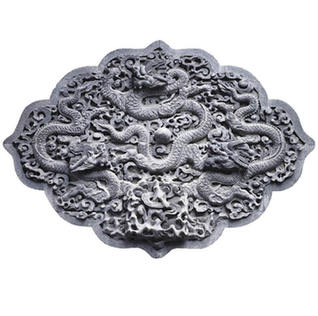|
Bricks from the same period found in a tomb in Shandong's Jinan demonstrate a different style – a combination of relief carving and painting. For example, a convex desk and two chairs are carved out of the brick, while a vase of flowers and a pot are painted on the brick's sunken side, creating the impression the items are standing on the table. The interior wall of the tomb is embellished with brick carvings modeled on a wooden structure. The simulated bracket system on the carved gateway still shows scaled vermilion paint typical of ancient wooden architecture. The tomb chamber is round and three meters in diameter. The circular wall is carved with furniture and articles of daily use. Skeletons of a man and a woman and a few bronze coins were unearthed from the tomb, which is believed to have belonged to a well-off couple. The tomb is valuable for the study of burial customs, architecture and brick carving during the Song Dynasty.
In the Northern Song Dynasty brick carvings mainly decorated tomb chambers, and sites unearthed in Henan, Shanxi, Gansu and other places all feature brick carvings embellishing their inner chamber walls. The number and quality of the carvings indicates the social status of the tomb owners, as they usually attempted to reflect the lives of the deceased.
Tombs from the Jin Dynasty (1115-1234, established in northern China by the Jurchens, ancestors of the Manchus) feature more sophisticated brick carvings. One discovered in Shanxi's Houma is particularly outstanding, as it is full of fantastic brick carvings that simulate wooden roof brackets, sunken ceilings, gateways, screen partitions, tables, chairs, flowers, poultry, human figures, and scenes of entertainment. The actors and actresses on the stage are vividly portrayed in relief.
Ornamental Home Architecture
Tomb brick carvings declined during the Yuan Dynasty, but were gradually introduced into other fields of architecture, including residential buildings and gardens. By the Ming Dynasty (1368-1644), brick carving was widely used to provide ornamentation for homes.
Wood, brick and stone carvings are characteristic ornamental features of ancient Chinese houses. They borrow from one another in artistic technique and design. Brick carving is mainly applied to exterior elements of courtyard houses, such as screen walls, gate towers, roofs and windows. By the Qing Dynasty, techniques had developed to a supreme level, both in craftsmanship and design, creating the golden era of Chinese brick carving. Many masterpieces from the period can still be seen today in large compound homes in Anhui, Shanxi, Beijing and some other places, built by rich officials and merchants of the Qing Dynasty.
 |
|
A brick carving in Beijing's Wanshou Temple. |
Traditional patterns of brick carving almost unanimously convey the message of good will and blessing. For example, five bats (a homophone of "happiness" in Chinese) surrounding a variation of the Chinese character "shou" (longevity) mean both happiness and longevity; a composition of pines and cranes symbolizes longevity; and a lion (or lions) playing with an embroidered ball is meant to guard a house against evil spirits. Lions also indicate a smooth career in officialdom, because in ancient Chinese the word was used interchangeably with the character meaning "tutor," which often appeared in the titles of high-ranking officials.
Apart from such patterns, characters were also often used to embellish screen walls inside, and sometimes also in front of, gateways to courtyard homes, to "lock in" family wealth and maintain privacy, while also fending off evil spirits. One of the most commonly used characters was longevity – "shou." A brick screen wall in the Qiao Family Mansion in Shanxi's Qixian County is carved with 100 seal-script variations of this character. Other common motifs include noble plants like plums, orchids, bamboo and chrysanthemums; vases and peonies that stand for wealth and peace; and the mythical "kylin" animal with boys, expressing hope for a flourishing family line.
A wide range of other motifs – human figures, landscapes, animals, birds, flowers, fairytales, theatrical stories and geometric patterns – can also be found in brick carvings decorating traditional Chinese homes. |
